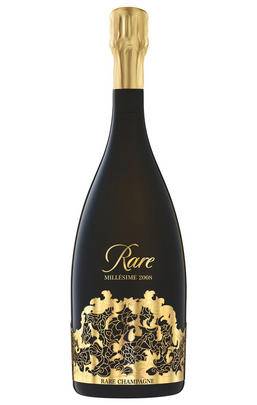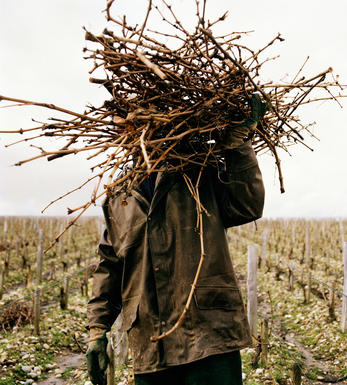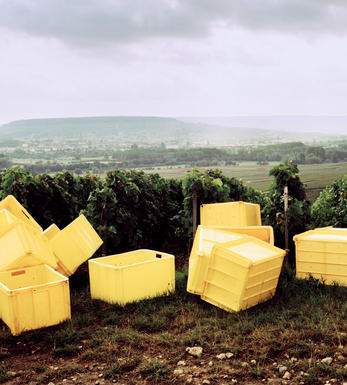
2008 Rare Champagne, Millésime, Brut

Critics reviews
The newly released 2008 Brut Cuvée Rare is very promising, unwinding in the glass with a youthfully reserved nose of citrus oil, crisp green apple, freshly baked bread, iodine and oyster shell, as well as some rather herbaceous characteristics that depress my score a little, even if I suspect that they will resolve with a bit more bottle age. Medium to full-bodied, incisive and tightly wound, if the 2006 vintage was gourmand and demonstrative, the 2008 is slower to show all its cards. Built around racy acids and complemented by a pillowy mousse, this rendition of Cuvée Rare will reward a few years more on cork.
Drink 2022 - 2045
William Kelley, Wine Advocate (September 2020)
70% Chardonnay, 30% Pinot Noir. 100% grand cru with the Chardonnay from Avize, Oger and Villers-Marmery and the Pinot Noir from Verzy. Aged on lees for ten years. Disgorged in November 2019 with a dosage of 8.5 g/l.
Smoky, Chardonnay-dominant nose. Lots of age on this, yet with an undertow of citrus freshness. Spreads right across the palate with both depth and finesse. Shows off the density and solidity of the vintage. Good for drinking now.
Drink 2020 - 2030
Jancis Robinson MW, JancisRobinson.com (December 2023)
Like a stallion out of the gate, this shows an initial explosion of power through mouthwatering flavours and fine texture before quickly settling into an elegant gait. The racy acidity is seamlessly knit, buoying the lacy mousse and flavours of cassis, toasted brioche and tangerine, with accents of candied ginger, hazelnut and fleur de sel lingering on the long, creamy finish.
Drink now through 2035
Alison Napjus, Wine Spectator (December 2020)
This has fantastic concentration, with notes of seashells, waxed and preserved lemons, blanched almonds, toasted coconuts and a smoky touch like tobacco and white ash. Waxy and textured, with very fine, almost imperceptible bubbles. Long, mineral and serious finish. Still tight. 70% chardonnay and 30% pinot noir, mainly from Montagne de Reims. Disgorged end of 2022. 8g/L dosage. Tasted from Magnum, which will be launched later this year.
Drink or hold
James Suckling, JamesSuckling.com (August 2023)
Rare Champagne boasts an illustrious past, with its first vintage presented to Marie Antoinette in 1785. The wine is produced in very limited quantities and is restricted to exceptional years, with only 11 vintages being declared over the past four decades of production. 70% Chardonnay, 30% Pinot Noir from selected Grand Cru vineyards.
Simon Field MW: Gentle bead, lovely evolved notes of hazelnut, even a hint of praline, enrobed and ennobled by firm acidity and a persuasive finish.
Alan Bednarski: Great, pure wine with still-fresh zesty flavours, delicate palate and sweet yeast notes, with a long flavourful finish of ripe melon.
Tim Hall: A challenging, pressing start, wanting to overwhelm with a shimmering and sharp attack, but shows intensity on the palate to match. Lovely lemon-apple notes and tempered texture.
Drink 2021 - 2028
Simon Field MW, Adam Bednarski, Tim Hall, Decanter.com (October 2021)
About this WINE

Rare Champagne
Award-winning winemaker Régis Camus is the mastermind behind Rare Champagne. From 2002 until 2018, he held the post of Cellar Master at renowned Champagne House, Piper-Heidsieck. Under his tenure, the Rare Millésime Champagnes attracted much acclaim, especially given that these wines are only released in the best vintages. So that he could better focus on the Rare Champagne range, Régis took the decision to leave Piper-Heidsieck and establish his own Champagne House. Rare Champagne, therefore, is now operating as a separate entity.

Champagne
Our wine buyers leave no stone unturned in their quest to find the best Champagnes, and Berry Bros. & Rudd takes particular pride in its eclectic range of artisan Champagnes that represent a real sense of terroir, original winemaking, labour-intensive viticulture (often organic/biodynamic) and the uncompromising excellence of the end product.
How Champagne is made
In 1668, in the village of Hautvillers, the monk turned cellar master, Dom Pérignon, is said to have discovered how to make sparkling wine; while the same technique is used all over the world today, the region of Champagne continues to make some of the finest.
So what makes wine sparkle? Adding a solution of sugar and yeast to a white wine starts another fermentation in the bottle which results in the bubbles. Once the yeasts have done their job, a sediment known as ‘lees’ collects on the side of the bottle; contact with this deposit during maturation gives the wine its characteristic flavours of freshly-baked bread, toast and biscuit. Once this sediment is isolated (remuage) and removed (dégorgement), the Champagne is topped up with a sugar solution to make it dry or sweet
The Champagne Wine Region
Champagne is the most northerly wine region in France and is situated north-east of Paris. There are three main vineyard areas: Côte des Blancs, Vallée de la Marne and Montagne de Reims.
Ripeness of the grapes is often a problem, which is one reason why a blend of grape varieties is usually used: the white Chardonnay to give fruit and elegance, and two reds – Pinot Noir (particularly to provide a ‘backbone’) and Pinot Meunier.
In Champagne there are around 15,000 growers and 290 Champagne houses. Traditionally, growers have sold their grapes to the Champagne houses which account for 70 percent of production and 90 percent of exports. Recently, increasing numbers of growers are making growers’ Champagnes themselves, using their own grapes.
The Champagne houses used to be organized into a Syndicat des Grandes Marques, which had 28 members, not all of them of equal quality. That has now been superseded by the Club des Grandes Marques, with 24 participants: Ayala, Billecart-Salmon, Bollinger, Canard- Duchêne, Deutz, Dom Pérignon, Heidsieck & Co. Monopole, Henriot, Krug, Lanson, Laurent-Perrier, Moët & Chandon, G.H. Mumm, Perrier Jouët, Joseph Perrier, Piper-Heidsieck, Pol Roger, Pommery, Ch. & A Prieur, Louis Roederer, Ruinart, Salon, Taittinger, Veuve Clicquot-Ponsardin.
Champagne Styles
Vintage Champagne
Made exclusively from grapes grown in a single year, this is produced only in the best years, and is released at about six years of age.
Non-Vintage Champagne
Most of the Champagne produced today is Non-Vintage, comprising the blended product of grapes from multiple vintages. Typically grapes from a single-year vintage will form the base of the blend, ranging from 15 percent to up to 40 percent.
Rosé Champagne
Typically light in colour, rosé Champagne is produced either by leaving the clear juice of black grapes to macerate on its skins for a brief time (known as saigneé), or by adding a small amount of Pinot Noir red wine to the sparkling wine cuvée. The saigneé method is more elaborate and costly, requiring highly-skilled winemaking, hence only a few houses still use it – among them Laurent Perrier and Louis Roederer.
Luxury (Prestige) Cuvée
Top of the range, this is vintage-dated. Famous examples include Louis Roederer's Cristal, Laurent-Perrier's Grand Siècle, Moët & Chandon's Dom Pérignon, Duval-Leroy's Cuvée Femme and Pol Roger's Cuvée Sir Winston Churchill.
Demi-Sec (Rich) Champagne
Demi-Sec or Rich is a medium-dry to medium-sweet style which occupies the other end of the spectrum from the standard dry "Brut" style. Brut Natural or Brut Zéro contains less than three grams of sugar per litre, Extra Brut has less than six grams of sugar per litre, and Brut less than 12 grams of sugar per litre.
Recently Disgorged Champagne
R.D. (Recently Disgorged) style was introduced for the first time by Madame Bollinger in 1961, on the 1952 Bollinger Grande Année vintage. Late disgorgement allows the Champagne to retain its freshness, vivacity and fruity expression, despite the ageing.
Blanc de Blancs Champagne
Blanc de Blancs denotes a Champagne made exclusively from Chardonnay grapes.
Blanc de Noirs Champagne
Blanc de Noir Champagnes are made exclusively from black grapes, Pinot Noir (typically) and Pinot Meunier grapes. Bollinger's prestige cuvée Vieilles Vignes Françaises is the lead example.

Champagne blend
Which grapes are included in the blend, and their proportion, is one of the key factors determining the style of most Champagnes. Three grapes are used - Pinot Noir, Chardonnay and Pinot Meunier.
26% of vineyards in Champagne are planted with Chardonnay and it performs best on the Côtes des Blancs and on the chalk slopes south of Epernay. It is relatively simple to grow, although it buds early and thus is susceptible to spring frosts. It produces lighter, fresher wines than those from Burgundy and gives finesse, fruit and elegance to the final blend. It is the sole grape in Blancs de Blancs, which are some of the richest long-lived Champagnes produced.
Pinot Noir accounts for nearly 40% of the plantings in Champagne and lies at the heart of most blends - it gives Champagne its body, structure, strength and grip. It is planted across Champagne and particularly so in the southern Aube district.
The final component is Pinot Meunier and this constitutes nearly 35% of the plantings. Its durability and resistance to spring frosts make the Marne Valley, a notorious frost pocket, its natural home. It ripens well in poor years and produces a soft, fruity style of wine that is ideal for blending with the more assertive flavours of Pinot Noir. Producers allege that Pinot Meunier lacks ageing potential, but this does not deter Krug from including around 15% of it in their final blends.


Buying options
Add to wishlist
Description
The Millésime Rare is an absolutely delicious Champagne, and a wonderful example of the quality of the 2008 vintage. Made up of 70% Chardonnay and 30% Pinot Noir, all grapes for the wine were sourced from Grand Cru villages. Initially delicate on the nose, it opens up in the glass to show aromas of sweet peach, dried flowers, almonds and white pepper. The palate is ripe with a rich mousse; it’s zesty and refreshing, with hints of pineapple, blood orange, liquorice and freshly-baked pastries.
Drink 2022 - 2035
Paul Keating, Account Manager, Berry Bros. & Rudd
wine at a glance
Delivery and quality guarantee